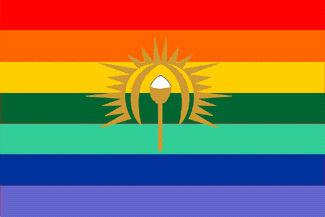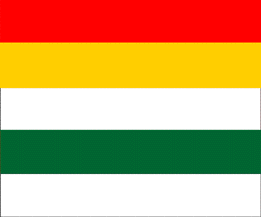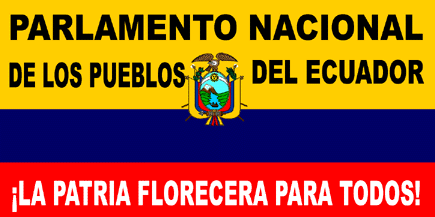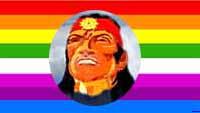
by Jaume Olle', 15 January 2000

Last modified: 2004-12-30 by dov gutterman
Keywords: ecuador | qwishwa | inca | conaie |
Links: FOTW homepage |
search |
disclaimer and copyright |
write us |
mirrors
See also:
Beside of the fact that there are some basic versioins of the
whipala, the flag is used toghether with the same flag but which
have squares in the rainbow colors instead of stripes (Kollasuyo)
the whipala with stripes is called the "tawantinsuyo"
flag, or the Inca flag, the inca nation flag, the quechua nation
flag. In ecuador they have also some variants. The original flag
is the striped whipala, which was the coat of armor of the Inca,
long before they started to think of having a own gay flag,
rainbow warrior or other rainbow using flags in this world.
Concering the flags which are used in the original Whipala, as
the images at this page EMBLEMA NACIONAL del PUSIN-SUYU =
TAWANTINSUYU- Huipala/wiphala, where and when did the rainbow
flag originate from?
The Indigenous banner is called " huipala" with the
seven colors of the rainbow (symbolizing the unity of indigenous
peoples before the conquest) and the black flags of
Ruminahui (legendary leader of the autonomous movement) and
Atahualpa La bandera indígena se llama : " huipala "
con los siete colores del arco iris (que simboliza la unidad de
la gente indígena antes de la conquista) y de los banderas
negros de Ruminahui (arranque de cinta legendario del
movimiento autónomo) y Atahualpa The Rainbow flag (Wipahla)
belong to the Native Andean people of Tahuantinsuyu for more than
500 years. Each color and its place in the flag as the rainbow,
have an own indigenous significance.
We have heard that the Indigenous org. of Cuzco , Peru is
thinking about finding another flag to symbolize our native
people, because of the problem above of using the flag by the
gays community and the International Co-operative Alliance,
claiming that they almost invented the flag in the 1920'ies.
Laila Holtet (<www.nativeweb.org>,webmaster
of CONAIE, Ecuador <conaie.org>),
9 July 2001
Today I saw in TV some Ecuadorian indigenous flags. I saw four flags clearly and another one quite well:
Ecuadorian Quichua Flag

by Jaume Olle', 15 January 2000
The first one seems to be the Ecuadorian Quichua flag. It is similar to the flag quoted by NAVA as "Inca" flags but with a sun in center. As is well known "Inca" is not a people but the name of the leader (empeor) of Quichua. According to NAVA there are 8 stripes but in the TV images there were only 7 (the white stripe is missinhg). Ratio c. 2:3
Ecuadorian Indigenous Flag

by Jaume Olle', 15 January 2000
The second flag seems to be the Ecuadorian indigenous flag: is fivestriped red, yellow, white, green, white. Ratio c. 5:6 o 4:5
Standart of the CONAIE

by Jaume Olle', 15 January 2000
The third flag seems to be the standart of the CONAIE (Confederacion de nacionalidades indigenas de Ecuador).It is a square, white, with a circular logo or seal in center. The seal is a circle of five colors: red, yellow, green, orange and white.
Unknown Indigenous Flag

by Jaume Olle' , 15 January 2000
The fouth is unknown .It is a scarlat flag , bordered white in hoist, fly and lower part. In the scarlat part is a golden emblem (details of emblem aproximate) . In the lower white part sew woeds are written but unafortunately I couldn't read them from the TV image.
Indigenous Parliament Flag

by Jaume Olle' , 15 January 2000
The last flag was the flag of the Indigenous Parliament. Is
the ecuadorian flag but with inscriptions: "Parlamento
nacional - de los pueblos del Ecuador" (National Parliament
of the Ecuador peoples) in black on the yellow stripe, and
"¡La patria florecera para todos! in white on the red
stripe. (¡Phaterland will florish for all!). In spanish
"florecera" must be write with accent in the last
"A" but in the image the accent is missing, however
since the words are in capital letters it is possible to supress
the accent.
Jaume Olle', 15 January 2000
In today Israeli newspaper "Yediot Akharonot" there
is a photo of a
demonstration of the Indigenous people Ecuador. Two flags can be
seen clearly. Each one has a different order of stripes. One is
looks like: purple-white-blue-green-yellow-orange-red. The second
looks like: red-yellow-green-light blue-purple.
Dov Gutterman, 23 January 2000
All the information above is dated from January 2000, and is
linked to the events, involving the active participation of
Indians, which caused the impeachment of president Jamil Mahuad.
According to 'Universalia 2000' (Encyclopaedia Universalis
Yearbook, published in 2001), the chronology of the events is as
following:
- On 6 January, the government declared a state of emergency
because of increase in popular protest. The Patriotic Front, a
coalition of several unions, called for the Christian-Democrat
president Jamil Mahuad, which had been elected in 1998, to
resign. The president's economical policy had been strongly
criticized for months and the country faced a severe crisis.
- On 9 January, the president announced US dollar would replace
the Ecuadorian sucre as national currency, in order to stabilize
the monetary depreciation. This announcement caused a
radicalization of the protest.
- On 11 January, the representatives of the Indian nations, which
constitute about 30% of the country population, created a
'Parliament of Ecuadorian Peoples' (Parlamento Nacional de los
Pueblos del Ecuador). They called for the president's resignation
and civil disobedience. [The Parliament flag is shown above]
- On 16 January, the spokesman of the Patriotic Front, Luis
Villacis, was arrested with two other leftist leaders, within the
context of the state of emergency.
- On 21 January, the Indians marched against the capital Quito
and besieged the Parliament. [The flags reported by Jaume were
probably filmed during the siege.] Under the Indian pressure,
president Mahuad left the presidential palace and a triumvirate
was set up to replace him, constituted of General Carlos Mendoza
(Minister of Defence and Chief of the Army Staff), Antonio Vargas
(president of the Confederation of Indigenous Nations of Ecuador
[CONAIE, whose flag is shown above), and Carlos Solorzano
(past-president of the Supreme Court). General Mendoza quickly
resigned and the triumvirate was dissolved.
- On 22 January, vice-president Gustavo Noboa announced he would
take over the power. The Parliament, called in Guyaquil,
impeached Mahuad. The Indians, understanding they had been conned
once again, left peacefully Quito. The new president announced he
would maintain the 'dollarization' of the economy.
- On 26 January, Gustavo Noboa was invested by Congress.
'Universalia 2000' shows a colour picture which might be the same
as the one reported by Dov. As stated by Dov, there are two
horizontally divided flags to be seen in the picture background:
- purple-white-blue-green-yellow-orange-red with apparent
proportion 1:2.
- red-yellow-green-light blue-blue-purple with apparent
proportion 3:4. Dov did report only one blue stripe, but there
are
clearly two of them on my source. Proportions are surely without
any signification because these flags were probably home-made.
It would be interesting to know if the different variations on
the same pattern (colour horizontal stripes) refer to different
nations or are simply variations on a basic pattern used by all
indigenous nations (for instance, the first flag shown above is
attributed to Quechuas [note that my dictionary uses both
Quechuas and Kechuas, but not Qwishwas]).
Ivan Sache, 31 May 2001

from <www.nativeweb.org>
"Alianza Indigena" flag as appear at <www.nativeweb.org/tawantinsuyu>.
At the same page you can see another Indigenous Flag.
Dov Gutterman, 2 June 2001
Alianza Indigena (Indigenous alliance) flag is the rainbow
flag with a disc in the center containing a portrait of the Inca
Rominahui as can be seen at <www.nativeweb.org>.
Interesting that the flag flown by the indigenous person in the
photo is a version close to that used by the gay community (6
stripes - Red, yellow, light green, olive green, blue, purple),
while the image in the page shows the flag of the gays (6 stripes
- red, orange, yellow, green, blue, purple) and the different
flag of the IA (8 stripes - red, orange, yellow, green, white,
lilac, dark purple, blue).
Jaume Olle', 3 June 2001
I am the person who designed the Ruminahui flag at my pages. Both
the American COOP and the gay comunity have using the inca flag ,
the rainbow and the serpent shied and Cuzco Inca flag of stripes
was "invented"! long before the europeans came to
America. The gay community have not answered any email about this
presented by the United Indigenous Tribal Representatives, nor
from CONAIE, The indigenous leaders of Cuzco or anyone else. The
old leaders in Cuzco have been thinking about changing the design
of their NATIONAL flag because of this.
Laila Holtet (<www.nativeweb.org>,webmaster
of CONAIE, Ecuador <conaie.org>),
9 July 2001